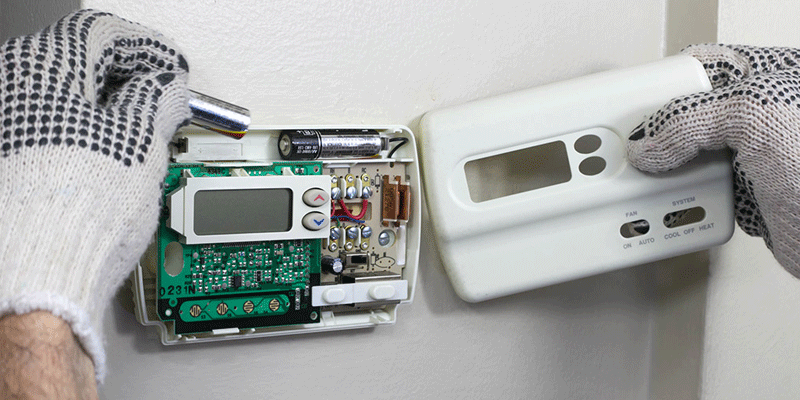
An HVAC system is a finely tuned machine requiring constant attention to ensure peak performance, efficiency, and comfort in your home. Sometimes, however, even the best-laid plans can go awry. One of the most common problems homeowners see with their systems is the thermostat. After years of constant use in harsh conditions both inside and out, it’s no wonder these devices start to struggle when they get older. And sometimes that leads to much more significant issues.
When should you replace an HVAC thermostat? Here are some signs that might indicate your old trusty device needs replacing:
You Have Trouble Controlling Temperature
If changing temperatures using your physical thermostat seems harder than normal-or if your indoor temperature doesn’t seem to change at all-the thermostat may be faulty and need replacement. You can face significant issues if your thermostat is unable to control the temperature, such as an increase in your energy bills or an uncomfortable indoor temperature.
It’s Getting Dirty
If dirt has begun to accumulate on your thermostat, it can interfere with the device’s ability to read temperature accurately. If you notice this problem, schedule a professional cleaning service for your HVAC unit. This will ensure that the accuracy of your system is maintained even when you replace your thermostat.
Your Thermostat is Old
Older units typically lose their power or accuracy over time, which means that if yours is more than ten years old (or approaching that age), it may be time for a replacement.
Your Thermostat Doesn’t Have Up-to-Date Features
If your thermostat doesn’t have features like LCD screens, programmability, or multi-zone capability, it may be time for an upgrade. You can get a free estimate of costs to replace your thermostat with Austin AC by reaching out via phone or email.
You Have Incorrect Temperatures
If you’ve recently spent time and money on renovations, make sure your new home improvement project isn’t negated by an incorrect thermostat reading. Pay attention to the temperatures around your HVAC unit-is it too cold or too hot? If it’s off, that means that the device is not accurately measuring the temperature in its surrounding environment, which can lead to much bigger problems down the road.
If you notice this problem, schedule a professional cleaning service for your HVAC unit. This will ensure that the accuracy of your system is maintained even when you replace your thermostat.
How an HVAC Thermostat Works
The thermostat is one of the most important parts of your HVAC unit. Without it, you’d have no way to accurately control the temperature in your home’s living spaces. The device measures the internal temperature of your home and activates (or deactivates) heat as needed. Depending on which model you own, there are different ways that your system will respond to changes in readings:
Basic Thermostats
These devices simply measure air temperatures around them and tell an HVAC unit when to start or stop heating (or cooling). They don’t make any adjustments for airflow or humidity levels-they simply turn systems on or off. These models are inexpensive and easy to install but don’t offer many options for adjusting your home’s temperature while you’re away.
Programmable Thermostats
When temperatures fall below a pre-set limit, these devices call for heat or cooling in order to maintain optimal conditions. Depending on the model, homeowners can program these thermostats to make adjustments automatically when they leave town-meaning that their systems will continue working without them there to control it. These models are usually very affordable and easy to install, but they lack extra features like humidity controls or automatic scheduling.
WiFi-Enabled Thermostats
These models are very similar to programmable thermostats with one important difference: They offer remote access through smartphone apps or web browsers so homeowners can adjust temperatures remotely no matter where they are. While this feature is convenient, it’s also the most expensive. You can get a free estimate for replacing your old thermostat with an Austin AC professional by reaching out to our team.
How to Maintain an HVAC System
By maintaining your HVAC unit, you can increase its lifespan and prevent it from malfunctioning at the worst possible times. The best way to do this is by changing filters regularly so that debris doesn’t settle inside the device. If dirt has begun to accumulate on your thermostat, it can interfere with the device’s ability to read temperature accurately.
Be Sure To Hire a Professional
It’s important to remember that an HVAC technician should always inspect the unit before making any changes or repairs. This is especially true in the event of unexpected malfunctions-homeowners who attempt to fix their own systems risk doing even more damage if they don’t know what they’re doing.
If you suspect there is something wrong with your system, schedule a professional cleaning and inspection with Austin AC today. We can provide homeowners with free estimates for replacement before we begin work, so you’ll know exactly how much it will cost to update your thermostat before you commit.
When to Replace Your Thermostat
The last thing you want after installing a new home improvement project is for an unexpected problem to crop up. For this reason, it’s important that you replace your thermostat promptly if you notice anything wrong with it or if its features fall below expectations. You should always have a professional make any repairs or part replacements to your unit.
Contact Us Today
You can learn more about replacing your HVAC thermostat with professional services today! At Austin AC, we offer affordable pricing for all of our work. To get a free estimate of costs for replacing your thermostat with an Austin AC professional, reach out to our team using the contact information provided above! We offer fast and affordable heating and cooling services, so you can schedule an appointment at any time.
